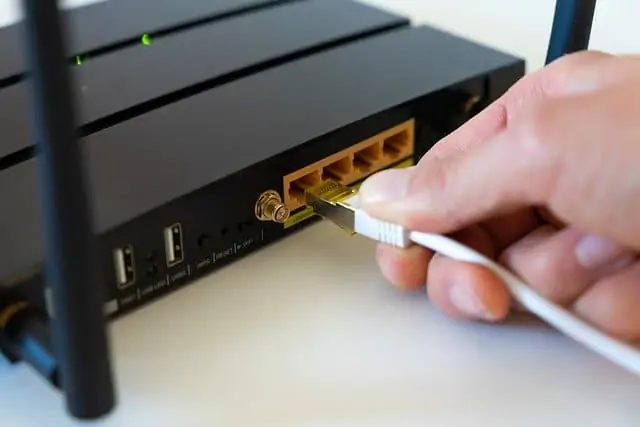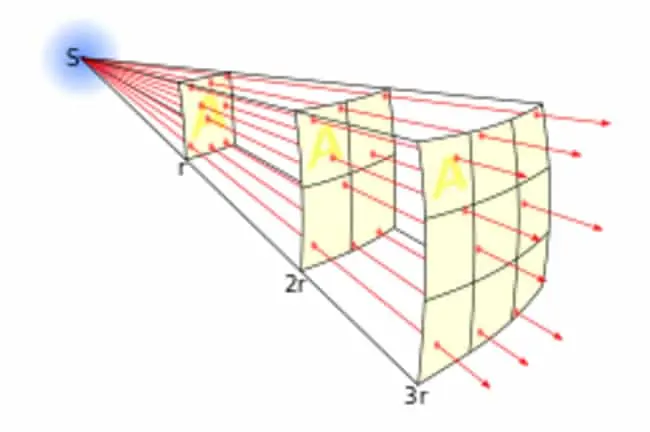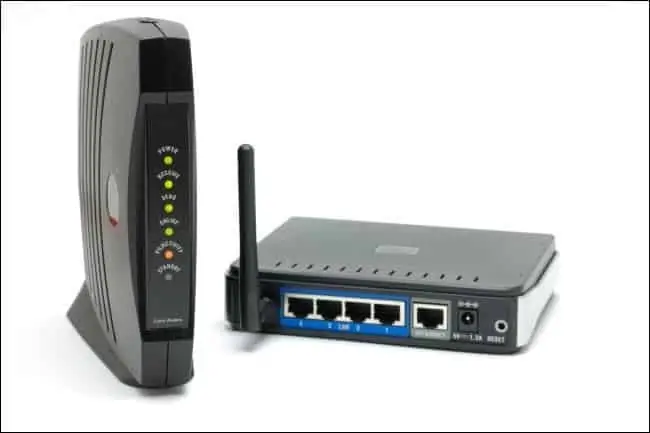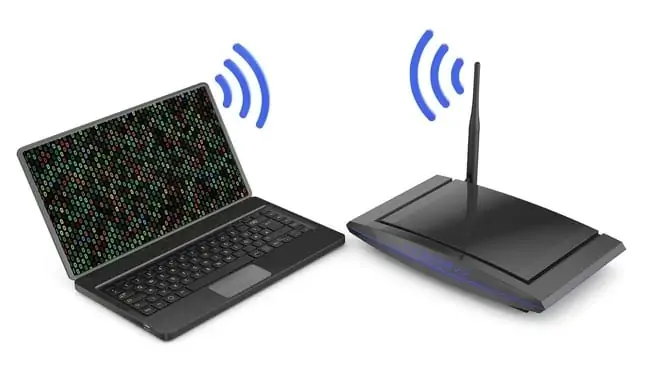This is a common question in home networking. Users want to know whether there’s actually any relationship between the distance from the router and the internet speeds they get. Does connecting to the router from further away affect the speeds we get at all?
The answer to this largely depends on how you are connecting to the router; here is a quick answer:
When connected by LAN/ethernet cable, the distance from the router should not affect internet speeds. When connecting via Wi-Fi, then speeds are likely to be reduced over distance, as the signal fades out the further you are away from the router as per the inverse square law of physics.
In other words, there is an inverse relationship between the distance from the router and the speeds delivered when using wireless connections – the further away you are, the lower your speeds are likely to be.
However, there are also other factors which can affect internet speeds, which we’ll also cover. Let’s look at the relationships between connection type, distance and speeds in more detail.
Clarifying comment – We also included “modem” in the title because sometimes terms get mixed up, but in almost all cases, what is actually meant is the “router”, since this is what devices actually connect to on a home network. The picture is confused by the fact that sometimes modems and routers are separate, and sometimes they are combined into one thing that is still sometimes casually referred to as a “Wi-Fi router/hub/station/box” etc. What we are talking about in most of this article is the distance between your devices and whatever they connect to to get online, whether it’s a combined modem-router or a separate router that’s connected by cable to separate modem, which then feeds out into the phone line/access panel.
Speed Should Not Be Affected When Connected By LAN Cable
Let’s first cover the simpler case – when you connect your device to the router by a LAN/ethernet cable, plugging into the back of one of the ports on the router.

In this case, the distance between the router and devices (in other words, the length of the network cable you are using) should not affect speeds, within reason. In other words, whether you are connecting to the router with a 1m ethernet cable or a 20m ethernet cable, the speeds you get should be the same, as long as the ethernet cable is in good condition and not frayed/twisted etc.
We add the “within reason” caveat because even the copper contained within an ethernet cable does have a range out of which the signal quality will start to degrade, but this is generally considered to be 100m or 300 ft+. Almost no users in the world will need to connect with cables this long; most use cables between 1 and 20 meters. So this range limit is not applicable to almost all home internet users.
Using different lengths of LAN cables to connect should have no impact on speeds in reality for everyday home users. You should get the same speeds regardless. If you are getting slower speeds than you expect when plugged in by cable, check the section and linked articles further below for some suggestions.
The Distance From The Router Will Affect Speeds When Connected By Wi-Fi
Now let’s turn to the more complex case of connecting devices to a router via Wi-Fi. In this case, the distance from the router will almost always affect internet speeds, meaning that the further you are from the router when on Wi-Fi, the slower your speeds are likely to be.
This is because Wi-Fi uses RF (radio frequency) waves, all of which are subject to the Inverse Square Law of physics, which dictates that all radio waves degrade over distance by a square of the distance from the source (in this case, the router).

Image credit – Wikipedia
In other words, doubling the distance decreases the intensity of the signal by a factor of 4 (inverse square of the distance), trebling the distance reduces strength by a factor of 9, and so on. There are sometimes ways of reducing this drop-off but generally the law will always hold when dealing with any RF/EMF waves.
In other words, no matter how good the Wi-Fi, the signal it emits will always weaken and disperse over distance, to the point that your signal will not be as good as if you were closer to it, and you will not get the same speeds as you would if closer, or plugged into the router with a LAN cable.
This is an unavoidable fact of using Wi-Fi technology and cannot really be changed. If you are on Wi-Fi and do a speedtest right next to the router, and then a few rooms away, you will often find the speeds are considerably lower.
Moreover, this drop off will likely be more pronounced the more walls, floors and other obstacles you put between your device and router, since the strength of the signal will be degraded and diminished even more than the Inverse Square Law dictates it already will be if the waves have to pass through more solid objects.
This is the constant battle internet providers and Wi-Fi router manufacturers are engaged in – trying to minimize the loss of signal strength and speeds over distance when using Wi-Fi. Routers do continue to get better, and home networking products like Wi-Fi extenders and Mesh Systems are meant to try and help with this by dispersing Wi-Fi more evenly over a home.
As long as we accept the limitations the current laws of physics though, Wi-Fi signal drop off and loss of speeds over distance will be something that’s always a factor to some extent.
Interested readers could also check out powerline adapters though as a clever way of bypassing Wi-Fi over distance and instead establishing a wired connection to your router even when further away from it by using the existing electrical wiring of the house and a pair of adapter plugs with embedded ethernet ports. This can avoid some of the speed drop off you’d get using Wi-Fi when further away from the router.
Bottom line – If you’re continuing to use Wi-Fi though, expect slower speeds the further you are from the router.
Some Tips To Improve The Wi-Fi Signal & Speeds
If switching to a wired connection isn’t really possible and you have to stay on Wi-Fi, we’ll quickly list some things you can try to improve the signal over distance and try to reduce the impact on speeds the further away you are:
- Quickly reset your router and devices.
- Move your router and devices closer together.
- Move your router to a more central location in the house if possible and practical. Moving it to a more elevated position can also sometimes improve the signal.
- Make sure your router is not too close to other RF/EMF emitting devices, like microwaves.
- Kick some people off the Wi-Fi (not usually practical!)
- Alternatively, use the Wi-Fi at less busy times when less people are using the home network.
- Make sure your router is updated to the latest firmware and drivers. Google your router brand and model and check for the latest drivers and how to install them.
- If there are any obvious and clear obstructions between your router and device that can be moved, then move them. (eg. movable furniture, stands, racks, household or DIY “stuff” lying around etc.)
- If you have had your current router a long time, also contact your ISP and see if there is a more up to date router they can send you with better performance.
- If your router is dual band, consider splitting devices onto separate bands, so no one band becomes too congested. Let some devices connect to the 2.4 GHz band and others to the 5 GHz band to spread traffic out.
And then for those willing to spend some money to solve the problem:
- You can also use some home networking products that boost the wireless signal, hopefully delivering better speeds over distance:
-
- Wi-Fi booster/extenders – single plug adapters that you plug into an outlet, which capture and amplify the existing signal. Can be bought cheaply but hit and miss in terms of performance.
- Wi-Fi Mesh – Much more expensive systems that consist of several nodes or pods you place around the home, which can deliver more comprehensive coverage and better overall speeds in larger houses.
-

Wi-Fi Mesh can give you a better signal and faster overall speed, but will set you back a lot of money
What Else Affects Internet Speeds?
Whilst distance from the router when using Wi-Fi is a key factor in the internet speeds you’ll get, it definitely isn’t the only factor. There’s plenty of other factors that can impact the speeds you get.
Here are some of them:
- Internet speeds are also affected by the number of users on a home network, since the total bandwidth on an internet service is shared between all users, and not a “per person” allocation. More current users = less speed for each user.
- Connection type is also a key factor as mentioned above. Wi-Fi is almost always going to be slower than ethernet (see here). Try to get onto wired ethernet instead of Wi-Fi if you want higher speeds. Powerline can be a good middle ground solution if it’s difficult to run a long cable directly.
- Internet speeds can also be affected by the number of users in the broader area as well. Speeds can be lower during peak usage times (evenings and weekends) when more people are at home using the internet.
- Sometimes, internet infrastructure can also be either faulty, down or undergoing maintenance, which can also reduce speeds, either for a single ISP or more generally in an area. Checking the downdetector website in your area can be a good way of finding out if this is going on.
- The quality of wireless technology in devices (Wi-Fi cards, network drivers etc) can also affect signal quality and speeds. Make sure all drivers are up to date, and also try quickly disabling and re-enabling your Wi-Fi network adapters to refresh connections. If you’re getting a weak signal even when right next to the router, then your hardware or router is likely faulty (see here).
- Sometimes your DNS servers can be inefficient and deliver much slower speeds than are possible. Try changing them.
Does The Distance Between The Modem And Router Affect Internet Speed?
This is a closely related question that is also sometimes searched online. In reality, many users probably really mean what we have already been talking about for the rest of this article – whether the distance between the modem/router and devices affects speed, and just have the terms mixed up a bit
However, for readers who literally do understand the difference between all these things and are actually asking this precise question, let’s answer it also here:
When the router and modem are separate, they are usually connected by an RJ-45 LAN cable, and therefore the distance between the router and modem should have no effect on speed. Ethernet cables suffer little to no degradation over distance up to at least 300 ft, so placing the router and modem further apart should not affect speeds.
When your home internet set up is such that your router and modem are separate (not bundled together in a “combi” Wi-Fi device), here is the general sequence of how your internet is likely to be set up:
- Your internet service comes in through the phone line/master socket/installation panel in the home, which sends and receives data from the street nodes/cabinets which feed out to the broader internet.
- This phone line/master socket usually has an RJ-11 phone line jack cable going into the back of the separate modem.
- The modem is then connected to the separate Wi-Fi router by an RJ-45 ethernet cable (looks similar but slightly different to an RJ-11 cable). See the picture below – the modem on the left would be connected to the router on the right by a LAN cable.

- Your home devices then connect to this Wi-Fi router (not the modem), either by plugging a LAN cable into the back of one of the ports, or connecting to the router’s Wi-Fi.
- Therefore the distance between the modem and router should not affect speed, whether they are connected by a 2m ethernet cable or a 20m ethernet cable, or even longer. The transmitted speeds should stay the same (or virtually the same) up to at least 100m (300 ft), as long as the ethernet cable is in good working order. Most users generally have the modem and router close together anyhow.
- However, what will affect the speeds is the distance and quality of the connection between the devices and the router, if connecting via Wi-Fi. See the points covered in the sections above. Distance, obstructions, number of users etc. will affect speeds when using wireless connections.
